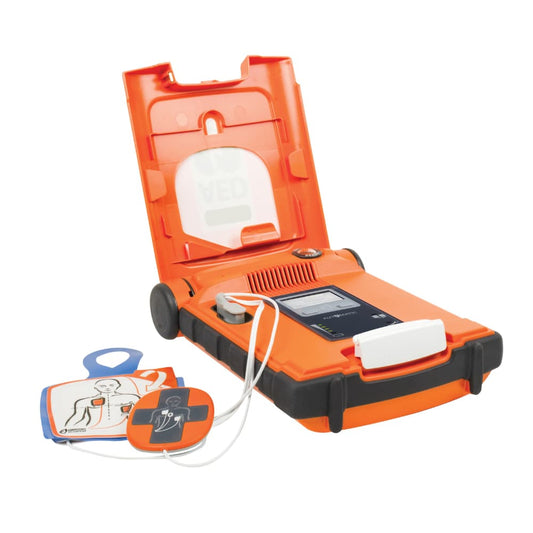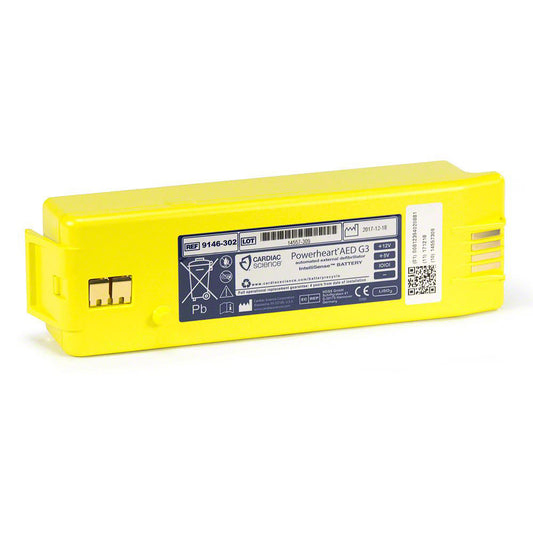-


Cardiac Science Powerheart G5 AED
<h2><strong>Enhance Safety with the Cardiac Science Powerheart G5 AED from Response Ready</strong></h2> <p><strong>What's Included:</strong></p> <ul> <li>New Cardiac Science Powerheart G5 AED</li> <li>Carry Case for easy portability</li> <li>8-Year Warranty for long-term peace of mind</li> <li>User Manual for comprehensive guidance</li> <li>Pre-Installed Pads & Battery for immediate use</li> <li>First Responder Kit included</li> <li>AED Inspection Card (I-Tag) for tracking maintenance</li> <li>“AED On-Site” Window Decal (AEDecal) for visibility</li> <li>Free Shipping for added convenience</li> </ul> <p><strong>Complimentary Accessories Worth Over $50:</strong></p> <ul> <li>Receive valuable accessories with your purchase.</li> <li>Explore <a href="/product/cardiac-science-powerheart-g5-aed-value-package/">Cardiac Science G5 Value Packages</a> for additional accessories and a cabinet.</li> </ul> <p><strong>Versatile and User-Friendly:</strong></p> <ul> <li>Suitable for both emergency services professionals and everyday users.</li> <li>Features RescueCoach™ voice and text prompts for guided CPR and defibrillation, ensuring ease of use.</li> </ul> <p><strong>Durable and Reliable:</strong></p> <ul> <li>Rugged design tested to military drop/shock standards.</li> <li>IP55 rating for protection against water and dust ingress.</li> <li>Rescue Ready® indicator for daily, weekly, and monthly self-tests.</li> </ul> <p><strong>Key Features:</strong></p> <ul> <li>Semi- or Fully Automatic Shock Delivery options for user preference.</li> <li>Variable Escalating Energy for optimized treatment based on heart response.</li> <li>Dual-Language Capabilities with pre-programmed language options.</li> </ul> <p><strong>FDA-Approved Innovation:</strong></p> <ul> <li>First FDA-approved AED with advanced features.</li> <li>Make informed decisions with automatic patient heart rhythm assessment.</li> </ul> <p><strong>Order from Response Ready:</strong></p> <ul> <li>Authorized Cardiac Science distributor.</li> <li>Guaranteed lowest price on the powerful Cardiac Science Powerheart G5 AED.</li> </ul> <p>Elevate your emergency response capabilities – order your Cardiac Science Powerheart G5 AED from Response Ready today!</p>
Cardiac Science Powerheart G5 AED
Regular price $2,157.00Regular priceUnit price per$200 OFF - Code: CARDIAC200
-

Cardiac Science Powerheart AED G3 Battery (9146-302)
<h2><strong>Response Ready: Cardiac Science Powerheart G3 AED Battery (Part Number 9146-302)</strong></h2> <p>Elevate the readiness of your Powerheart G3 AED with our medical-grade replacement battery, designed specifically for the G3 AED device. The Cardiac Science Intellisense battery, featuring Rescue Ready technology, establishes seamless communication with your G3 defibrillator, conveying crucial battery performance, capacity, and vital information.</p> <p><strong>Key Features:</strong></p> <ul> <li> <strong>Daily Self-Testing:</strong> The original G3 AED battery undergoes daily self-tests to ensure continuous readiness for sudden cardiac arrest emergencies.</li> <li> <strong>Four-Year Performance Guarantee:</strong> Each Intellisense® battery is backed by a four-year performance guarantee, providing long-lasting reliability.</li> <li> <strong>State-of-the-Art Technologies:</strong> Renowned for STAR Biphasic and RescueCoach technologies, the Powerheart G3 AED is a life-saving marvel.</li> </ul> <p><strong>Original PowerHeart G3 AED Replacement Battery:</strong></p> <ul> <li> <strong>Longevity:</strong> Boasting a life of four years from the date of manufacture, ensuring extended reliability.</li> <li> <strong>Recyclable:</strong> As a lithium battery, proper recycling is recommended. Utilize battery-recycling drop-off locations in your area.</li> </ul> <p><strong>Compatibility:</strong></p> <ul> <li>Intended for use with Powerheart G3 defibrillators: 9300E, 9300A, 9390E, and 9390A.</li> <li>The G3 AED device conducts daily self-tests to ensure software, hardware, pads, and battery are in optimal condition.</li> </ul> <p><strong>Why Choose Genuine Cardiac Science Parts:</strong></p> <ul> <li> <strong>Manufacturer Assurance:</strong> This is an authentic Cardiac Science Powerheart AED G3 replacement battery from the manufacturer.</li> <li> <strong>Warranty Protection:</strong> Purchasing authorized manufacturer parts ensures the integrity of your Cardiac Science warranty.</li> <li> <strong>Reliable Source:</strong> AED Leader is your trusted provider of genuine <a href="/">AED devices</a> and accessories.</li> </ul> <p><strong>Order with Confidence from Response Ready:</strong></p> <ul> <li> <strong>Authorized Distributor:</strong> As an authorized Cardiac Science distributor, we deliver authentic and reliable products.</li> <li> <strong>Free Shipping:</strong> Enjoy free shipping on all orders over $99, making it convenient for you to maintain your AED's readiness.</li> <li> <strong>Emergency-Ready Assurance:</strong> Keep a spare battery on hand to ensure your defibrillator is always ready for emergencies.</li> </ul> <p><strong>Ensure the Lifespan of Your AED – Order Today:</strong> Choose Response Ready for your Cardiac Science Powerheart G3 AED replacement battery. Order now to experience top-tier reliability and ensure your AED is always prepared for life-saving action.</p> <p><em>For inquiries or assistance, contact us. Your AED readiness is our priority.</em></p>
Cardiac Science Powerheart AED G3 Battery (9146-302)
Regular price $499.00Regular priceUnit price per




